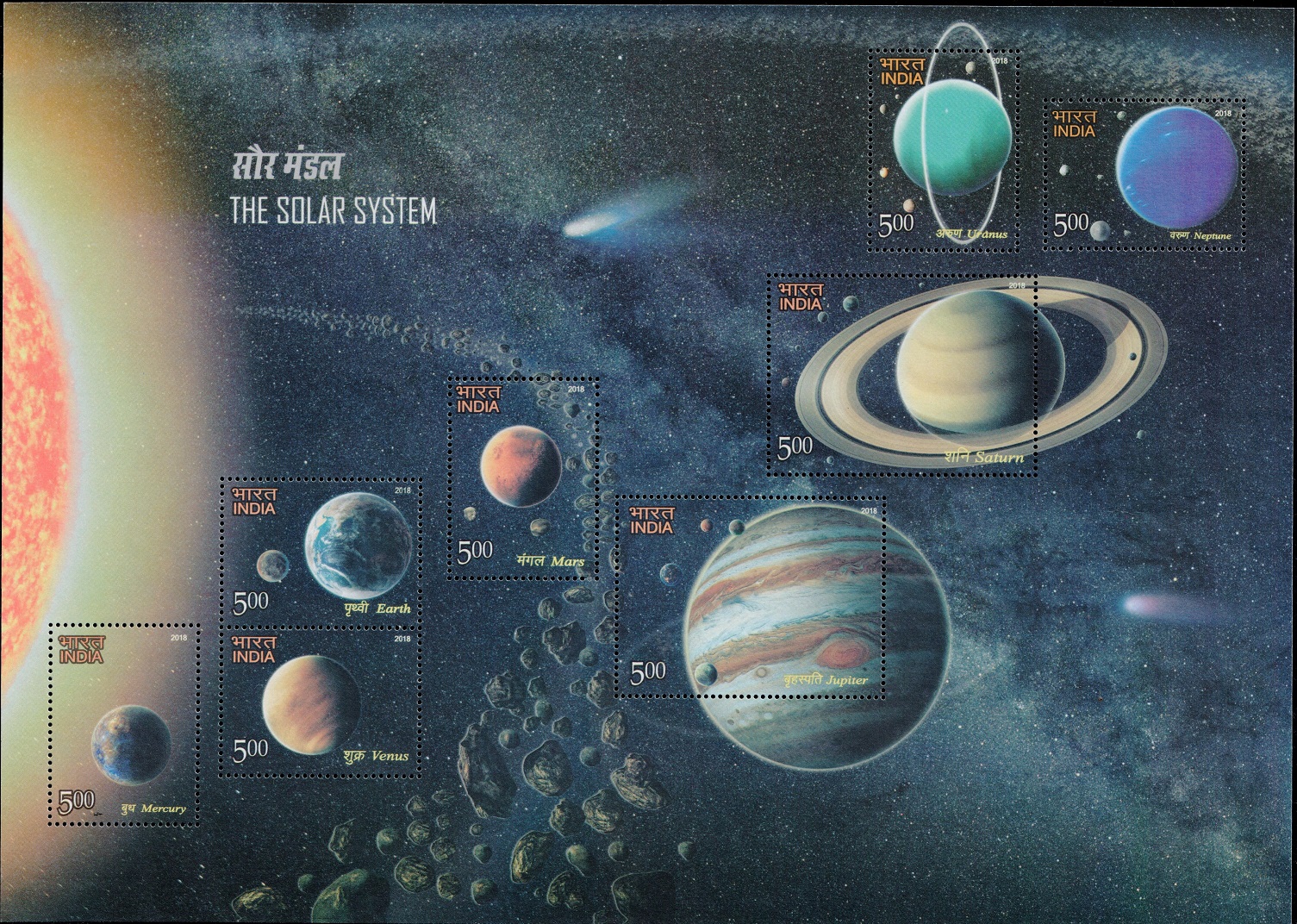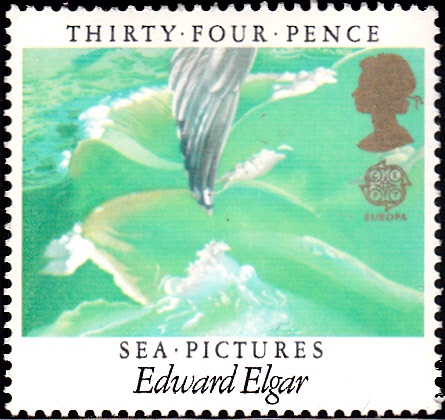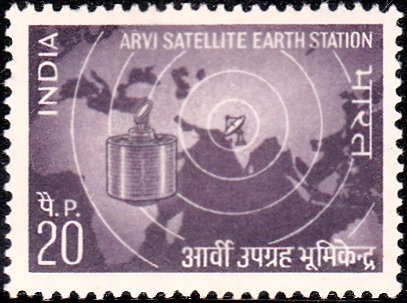
India on Solar System
Complete set of 8 nos. of commemorative postage stamps on the Solar System :








 Issued by India
Issued by India
Issued on Mar 20, 2018
Issued for : Department of Posts is pleased to issue a set of 8 Commemorative Postage Stamps depicting 8 planets of our Solar System on the theme “The Solar System”.
Credits :
Stamps/Sheetlets/Miniature Sheet/First Day Cover/Brochure : Shri Suresh Kumar
Cancellation Cachet : Smt. Alka Sharma
Type : Miniature Sheet, Mint Condition
Colour : Multi Colour
Denomination : 500 Paise (8)
Stamps Printed : 5.0 lakh each in the form of sheetlets
Miniature Sheets Printed : 110000
Printing Process : Wet Offset
Printer : Security Printing Press, Hyderabad
About :
- The Solar System includes the Sun, Earth and the Moon, the major planets including Mercury, Venus, Mars, Jupiter, Saturn, Uranus, and Neptune, their satellites, as well as smaller bodies including comets, asteroids, and dust.
- For many thousands of years, astronomers maintained a geocentric world view and did not recognize the existence of a Solar System. Most believed that Earth was stationary at the center of the Universe and categorically different from the divine or ethereal objects that moved through the sky. In 17th-century, Galileo Galilei, Johannes Kepler, and Isaac Newton, developed a modern understanding of physics that led to the gradual acceptance of the idea that Earth moves around the Sun and that the planets are governed by the same physical laws that govern Earth. Galileo Galilei was the first to discover physical details about the individual bodies of the Solar System. He discovered that the Moon was cratered, that the Sun was marked with sunspots, and that Jupiter had four satellites in orbit around it. Christiaan Huygens followed on from Galileo’s discoveries by discovering Saturn’s moon Titan and the shape of the rings of Saturn. Giovanni Domenico Cassini later discovered four more moons of Saturn and the Cassini division in Saturn’s rings. Edmond Halley realised in 1705 that repeated sightings of a comet were recording the same object, returning regularly once every 75-76 years. This was the first evidence that anything other than the planets orbited the Sun. Around this time (1704), the term “Solar System” first appeared in English.
- The first four planets, Mercury, Venus, Earth and Mars are much nearer to the Sun than the other four planets. They are called the inner planets. The inner planets have very few moons.
- Mercury:
- Mercury is the smallest and innermost planet in the Solar System. Its orbital period around the Sun of 88 days is the shortest of all the planets in the Solar System. Mercury is a rocky body like Earth, with an equatorial radius of 2,439.7 kilometres which is 0.3829 times the radius of the Earth. Mercury consists of approximately 70% metallic and 30% silicate material. Its density is the second highest in the Solar System at 5.427 g/cm3, only slightly less than Earth’s density of 5.515 g/cm3. Atmosphere is absent in Mercury and its surface temperature ranges from 100 K to 700 K.
- Venus:
- Venus is the second planet from the Sun, orbiting it every 224.7 Earth days. It has the longest rotation period (243 days) of any planet in the Solar System and rotates in the opposite direction to most other planets. Venus is sometimes called Earth’s “sister planet” because of their similar size, mass, proximity to the Sun, and bulk composition. It has the densest atmosphere of the four innermost planets, consisting of more than 96% carbon dioxide. The atmospheric pressure at the planet’s surface is 92 times that of Earth. Venus is by far the hottest planet in the Solar System, with a mean surface temperature of 735 K (462 °C), even though Mercury is closer to the Sun. The diameter of Venus is 12,103.6 km – only 638.4 km less than Earth’s – and its mass is 81.5% of Earth’s.
- Earth:
- Earth is the third planet from the Sun and the only planet on which life is known to exist. Earth formed over 4 billion years ago. Earth’s gravity interacts with other objects in space, especially the Sun and the Moon, Earth’s only natural satellite. Earth revolves around the Sun in 365.26 days, a period known as an Earth year. Earth’s mass is approximately 5.97×1024 kg. It is composed mostly of iron (32.1%), oxygen (30.1%), silicon (15.1%), magnesium (13.9%), sulfur (2.9%), nickel (1.8%), calcium (1.5%), and aluminium (1.4%), with the remaining 1.2% consisting of trace amounts of other elements. The atmosphere of Earth has a composition of 78% nitrogen and 21% oxygen, with trace amounts of water vapour, carbon dioxide, and other gaseous molecules. The mean density and surface gravity of Earth is 5.514 g/cm3 and 9.807 m/s2 respectively.
- Mars:
- Mars is the fourth planet from the Sun, orbiting it in 687 (Earth) days. It is the second-smallest planet in the Solar System after Mercury. It appears slightly reddish because the reddish iron oxide prevalent on its surface and is often referred to as the “Red Planet”. Mars is approximately half the diameter of Earth. Mars is less dense than Earth, having about 15% of Earth’s volume and 11% of Earth’s mass, resulting in about 38% of Earth’s surface gravity. Mars surface temperatures vary from lows of about -143 °C at the winter polar caps to highs of up to 35 °C in equatorial summer. The wide range in temperatures is due to the thin atmosphere which cannot store much solar heat.
- There is a large gap in between the orbits of Mars and Jupiter which is occupied by a large number of small objects that revolve around the Sun. These are called asteroids.
- The planets outside the orbit of Mars, namely Jupiter, Saturn, Uranus and Neptune are much farther off than the inner planets. They are called the outer planets. They have a ring system around them. The outer planets have large number of moons.
- Jupiter:
- Jupiter is the fifth planet from the Sun and the largest in the Solar System. It is a giant planet composed primarily of gaseous and liquid matter. It is so large that about 1300 earths can be placed inside this giant planet. However, the mass of Jupiter is about 318 times that of our Earth. Jupiter’s upper atmosphere is about 88-92% hydrogen and 8-12% helium by percent volume of gas molecules. Its orbital period is approximately 4332.38 Earth days, or 11.86 years. Jupiter has a large number of satellites. It also has faint rings around it.
- Saturn:
- Saturn is the sixth planet from the Sun and the second-largest in the Solar System, after Jupiter. It is a gas giant with an average radius about nine times that of Earth. It has only one-eighth the average density of Earth. Its density is less than that of water. However, Saturn is over 95 times more massive than Earth. Saturn’s interior is probably composed of a core of iron-nickel and rock (silicon and oxygen compounds). This core is surrounded by a deep layer of metallic hydrogen, an intermediate layer of liquid hydrogen and liquid helium, and finally a gaseous outer layer. Temperatures on Saturn are normally -185 °C. It takes Saturn 10,759 Earth days (or about 29½ years), to finish one revolution around the Sun. Saturn is probably best known for the system of planetary rings that makes it visually unique. Saturn also has a large number of satellites.
- Uranus:
- Uranus is the seventh planet from the Sun. Uranus’s atmosphere is similar to Jupiter’s and Saturn’s in the primary composition of hydrogen and helium, but it contains more “ices” such as water, ammonia, and methane, along with traces of other hydrocarbons. It is the coldest planetary atmosphere in the Solar System, with a minimum temperature of 49 K (-224 °C). The interior of Uranus is mainly composed of ices and rock. Uranus orbits the Sun once every 84 years. The rotational period of the interior of Uranus in 17 hours, 14 minutes. Uranus’s mass is roughly 14.5 times that of Earth. Its diameter is four times that of Earth. A resulting density of 1.27 g/cm3 makes Uranus the second least dense planet, after Saturn.
- Neptune:
- Neptune is the eighth and farthest known planet from the Sun in the Solar System. It is the fourth-largest planet by diameter, the third-most massive planet, and the densest giant planet. Neptune is 17 times the mass of Earth. Neptune orbits the Sun once every 164.8 years. Like Jupiter and Saturn, Neptune’s atmosphere is composed primarily of hydrogen and helium, along with traces of hydrocarbons and possibly nitrogen, but it contains a higher proportion of “ices” such as water, ammonia, and methane. Neptune’s outer atmosphere is one of the coldest places in the Solar System, with temperatures at its cloud tops approaching 55 K (-218 °C). Temperatures at the planet’s centre are approximately 5,400 K (5,100 °C).
- Text : Based on the material available on internet.








[…] left side of the stamp facing a rising sun on the right side with his right hand pointing to the planet Mars appearing in the right hand corner against a blue sky studded with a few yellowish […]
[…] celebration is based on a distinct set of astrological positions of the Sun, the Moon and the Jupiter. The celebrations occur at the exact moment when these positions are fully occupied, as it is […]
[…] as fruitful. The exploration of the moon may further extend to other planets probably including Jupiter and Mercury. By 1980, scientists probably will have answered definitely the question whether […]